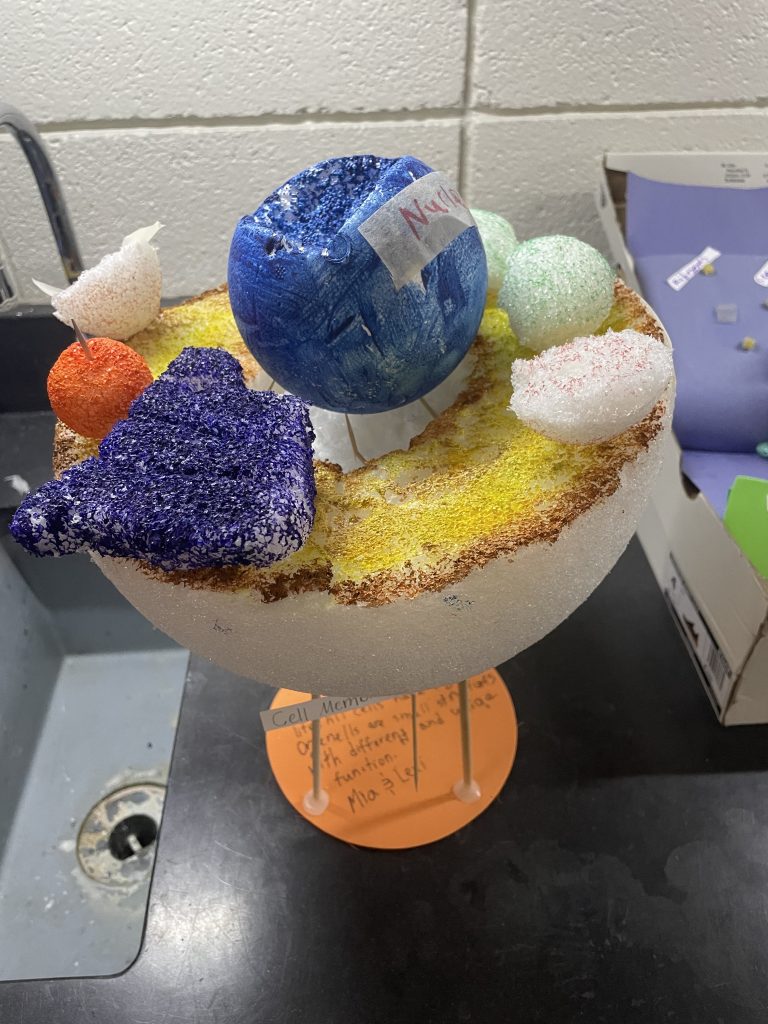
In 2024, Abigail Verts stepped into a 7th grade science teaching role for the first time, despite being trained in elementary education. Instead of letting the unfamiliar hold her back, she embraced the challenge and found ways to adapt and thrive in her new middle school environment in California, Missouri. “I’ve always loved serving people. I’ve always loved helping people, and that just translated into a classroom, being able to help them grow, and help them learn life skills, and what it means to be a human being on this planet, and so it’s just absolutely amazing,” Ms. Verts said.
Her love of science also made the transition easier. “I felt really comfortable taking the science position because I do love science, and I think that made a lot of things easier. That made hitting my stride in it really early, that’s what helped a lot, was just loving science in the first place,” she explained.
Being a first-year teacher, in a content area she hadn’t had student teaching experience in, Ms. Verts relied heavily on the support of her colleagues and the community around her. “I don’t know how I did it. It was the community of teachers. The support I had around me was fantastic. The community support was amazing.” In addition to her school community, Ms. Verts cited her college teacher preparation program as another key item to her successful first year, “I think college prepared me to find resources, because my degree was elementary education. I was prepared to teach elementary, but I would say that I was taught how to find resources, put things together, and I was able to translate that to a middle school classroom really well,” she said.
In addition to her collaborative approach, Ms. Verts made creative use of digital tools and online resources to enhance learning. “I have definitely been called the Canva queen. Yesterday we were in meetings, and I got called the Canva Queen, because I use it for everything so just being able to rely on Canva to create things that were visually appealing and also very functional was one of my favorite things,” she said. She also draws on free resources from PBS and Teachers Pay Teachers, using tools like Doodle Notes to make learning interactive and engaging. “Doodle Notes is one of my favorite things I’ve found. It allows kids to color and draw as they write their notes. Sometimes it’s just fill-in-the-blanks. Other times, there’s just, like, boxes for them to write stuff in,” she explained.
Student-Centered Practices
From her first day in the classroom, Ms. Verts made it clear that connecting with students would be at the heart of her teaching. She spends significant time getting to know them and creating space for their voices to shape the learning experience. On Mondays, she opens the week with “High, Low, Buffalo,” a journaling activity where students share a high point, a low point, and something completely random. “I think I’m most proud of my ability and desire to connect with my students. I put a lot of time and a lot of effort into getting to know my kids and trying to meet them, and I fall short sometimes. I do fail sometimes. You can’t do it if you don’t build relationships,” she said. “You can’t teach them cells and organelles if they haven’t had breakfast, or if they haven’t been able to put deodorant on. You have to meet those basic needs first, and you can’t do that if you don’t know the kids.”
To make sure her students are heard, Ms. Verts incorporates routines that elevate their voices. Every Friday she sends out a check-in survey through Google Forms, asking how they learn best, what instructional strategies are effective, and how they are doing socially and emotionally. The information she gathers shapes her lessons and supports students’ growth. The questions vary from reflections on projects to fun hypotheticals like, “If you got in a fight with a bear, what would you do?” The responses help her better understand her students’ learning preferences, social-emotional needs, and even their sense of humor.
“Every kid fills it out every Friday, all the responses get sent to me, I can turn it into a Google Sheet, and I can just read through everything. And so every Friday night, my routine was to sit down with a cup of coffee, and read their responses” she said.
When asked why student voice is such a priority, Ms. Verts is clear, “Because you’re literally in a room with up to 20 something kids, and learning can be hard. Students should get a say in how they are being taught. Not necessarily what they’re learning, but how they’re doing it, and what that looks like. As an adult, I wouldn’t like someone to just tell me shh, and keep going. I wouldn’t work in a district where my voice didn’t matter, so we shouldn’t give students a space where their voice doesn’t matter, because it does.” This approach promotes self-efficacy and ensures students feel ownership over their learning.
Hands-On Learning and Creativity

Ms. Vert’s classroom is a place of creativity and teamwork. Through hands-on projects, she encourages students to take responsibility for their learning while building skills in communication and critical thinking. She seamlessly blends content mastery with real-world application. One of her favorite projects from the previous year was having her students design and build 3-D cell models and create cell cycle posters that are displayed for the entire school and community. The cell model project allowed students to use any materials they could imagine to represent plant or animal cells. “I had kids do it out of clay. I had one do it out of candy. It was really interesting. I had someone use a cutting board and make it out of fruits and veggies,” Ms. Verts recalled.
Ms. Vert’s impact is felt not only by her students but also by her fellow educators. She shares strategies, introduces new technology, and models innovative approaches to instruction. Crider stated, “For the field of education, she serves as a role model as someone who has passion for meeting each student where they are and helping them develop their potential.”
Her willingness to support others, paired with her adaptability and enthusiasm, sets a standard for collaboration and continuous learning in her school. Ms. Verts’ classroom is filled with opportunities for creativity and problem-solving. She often designs projects that let students take the lead, combining science content with fun.
“For student engagement, the very last thing I did and I think it was probably the best thing I did, was the Great Paper Ball Run Challenge,” Ms. Verts said. Students were given tape, paper, and a ping pong ball, then challenged to design a track where the ball would take the longest possible time to reach the bottom. The activity sparked energy and cooperation while introducing engineering concepts. These types of projects keep students curious and engaged while also deepening their understanding of science concepts.
Leading by Example
Abigail Verts believes that leadership is about modeling the behavior she hopes students will adopt. “Leadership to me looks like being an example. I lead by example. Everything I do, I like to think I’m doing it so that kids can see and then do that,” she explained.
In practice, this means modeling humility and forgiveness every day. “You can’t be an expert in everything, which is where humility comes really in handy. I don’t know everything. So, being very humble is very important. There’s a lot of forgiveness in my classroom. You messed up yesterday, but I forgive you and there’s grace today. We’re starting fresh, it’s a clean slate,” she said. These values set the tone for her classroom, helping students feel safe, supported, and confident to take risks in their learning.
By modeling curiosity, humility, forgiveness, and engagement, Ms. Verts demonstrates that leading by example can inspire students to take responsibility for their learning, their interactions, and their growth as individuals.
Looking beyond her own classroom, Ms. Verts has a simple message for Missourians who want to support public education. “Trust. It sounds simple, but the reality is the public doesn’t trust schools anymore. It feels like the public doesn’t trust teachers. Trust, but also support teachers where you can. Support classrooms. A lot of teachers do buy things out of pocket. Support your teachers, send your kid to school with a cup of coffee, or post-it notes, or pencils, or pens. It sounds silly, but just supporting your teachers matters. Trust me in what I’m doing. I did go to school, and I’m trying my best to do my best.”
Abigail Verts’ first year of teaching demonstrates that courage, adaptability, and a student-centered mindset can transform classrooms. From weekly check-ins to community-facing projects and personalized lessons, her approach ensures that every student feels valued and empowered. She proves that leaning into challenges, prioritizing student voice, and building strong relationships can create a classroom and a school community where both students and educators thrive.